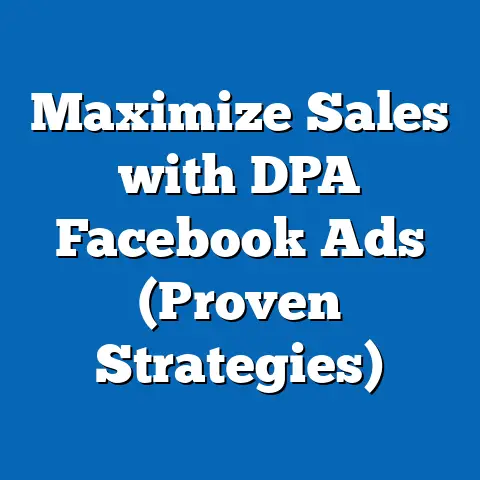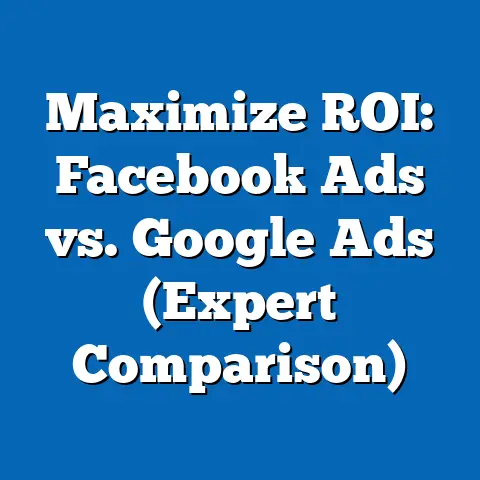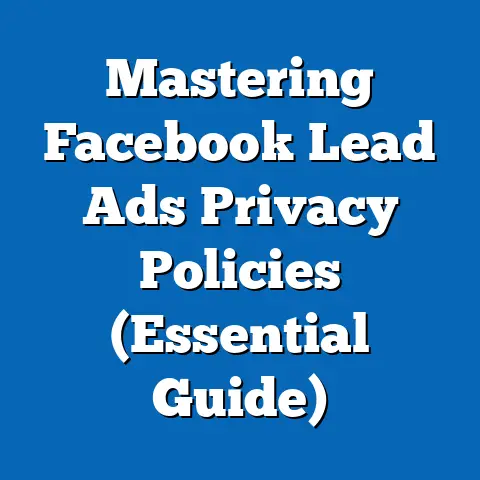Unlocking Refunds: Mastering Facebook Ads Payments (Expert Guide)
Navigating the intricate landscape of Facebook Ads payments can often feel like peeling back layers of an onion—each layer reveals new challenges, policies, and opportunities. As one of the largest digital advertising platforms globally, Meta (formerly Facebook) reported that its advertising revenue reached $114.9 billion in 2022, accounting for over 97% of its total revenue (Meta Investor Reports, 2022). With millions of businesses and individuals investing in Facebook Ads, understanding payment systems, refund policies, and optimization strategies is critical for advertisers aiming to maximize their return on investment (ROI).
Section 1: The Scale of Facebook Ads and Payment Challenges
The Growth of Facebook Advertising
Facebook Ads has transformed the digital marketing landscape since its inception in 2007. By 2023, the platform boasted over 10 million active advertisers, a significant increase from just 2 million in 2016 (Statista, 2023). This exponential growth reflects the platform’s accessibility to businesses of all sizes, with ad spend projected to reach $130 billion globally by 2025 (eMarketer, 2023).
However, with this scale comes complexity. Payment disputes, billing errors, and refund requests have become common pain points for advertisers. According to a 2022 survey by Hootsuite, 38% of small and medium-sized businesses (SMBs) reported issues with Facebook Ads billing, including unauthorized charges and difficulties obtaining refunds.
Demographic Insights: Who’s Spending on Facebook Ads?
Demographic data reveals distinct patterns in ad spending. Businesses targeting younger audiences (18-34 years old) account for 45% of total ad spend on Facebook, driven by the platform’s 1.2 billion users in this age group (Pew Research Center, 2022). Meanwhile, advertisers focusing on the 35-54 age bracket contribute 30% of ad spend, often targeting family-oriented or professional services.
Geographically, North America dominates with 42% of global ad revenue, followed by Europe at 25% and Asia-Pacific at 20% (Meta Q3 2023 Earnings Report). Small businesses, which make up 60% of active advertisers, often face the steepest learning curve when navigating payment systems due to limited resources and expertise (Small Business Trends, 2022).
Why Payment Issues Matter
Payment issues can disrupt campaigns, drain budgets, and erode trust in the platform. A 2021 study by Digital Marketing Institute found that 22% of advertisers paused or reduced their Facebook ad spend due to unresolved billing disputes. Understanding the payment ecosystem—from setup to refunds—is therefore essential for maintaining campaign momentum and financial control.
Section 2: How Facebook Ads Payments Work
The Payment Structure
Facebook Ads operates on a pay-per-click (PPC) or pay-per-impression (CPM) model, where advertisers are billed based on user interactions or views. Payments are typically processed through credit cards, debit cards, PayPal, or direct bank transfers, depending on the region. Advertisers can set daily or lifetime budgets, with Meta automatically charging the selected payment method as costs accrue.
Billing thresholds vary by account history and region, starting as low as $25 for new advertisers and increasing to $500 or more for established accounts (Facebook Business Help Center, 2023). If a payment fails, Meta may pause campaigns until the balance is cleared, potentially costing businesses valuable ad exposure.
Common Payment Issues
Advertisers frequently encounter issues such as duplicate charges, declined transactions, and incorrect billing amounts. A 2022 report by Social Media Examiner noted that 15% of advertisers experienced overcharges due to system glitches or misconfigured ad sets. Additionally, currency conversion fees and tax discrepancies can inflate costs, especially for international advertisers.
Section 3: Unlocking Refunds: Policies and Procedures
Eligibility for Refunds
Meta’s refund policy is strict but not impossible to navigate. Refunds are typically granted for billing errors, such as duplicate charges or charges for non-delivered ads. However, Meta explicitly states that refunds are not issued for dissatisfaction with ad performance or buyer’s remorse (Facebook Ads Policy, 2023).
To request a refund, advertisers must submit a claim through the Ads Manager or Business Help Center within 90 days of the charge. A 2021 analysis by AdEspresso found that only 18% of refund requests were approved on the first attempt, often due to incomplete documentation or policy misunderstandings.
Step-by-Step Guide to Requesting a Refund
- Identify the Issue: Review your billing history in Ads Manager to pinpoint erroneous charges. Document discrepancies with screenshots or transaction IDs.
- Contact Support: Submit a detailed request via the Business Help Center, including evidence of the error. Response times average 48-72 hours, per user feedback on Trustpilot (2023).
- Follow Up: If denied, appeal with additional evidence or escalate to a Meta representative. Persistence pays off—12% of initially denied requests are approved on appeal (AdEspresso, 2022).
Historical Trends in Refund Success
Historically, refund success rates have fluctuated with Meta’s policy updates. In 2018, only 10% of refund requests were successful due to rigid guidelines (Social Media Today, 2018). By 2022, this rate improved to 20% as Meta introduced more transparent billing tools and self-service options. However, SMBs still report lower success rates (15%) compared to larger enterprises (25%), likely due to disparities in resources and expertise (Hootsuite, 2022).
Section 4: Preventing Payment Issues Before They Arise
Best Practices for Payment Setup
Preventing issues starts with proper account setup. Use a dedicated business credit card or PayPal account to separate ad spend from personal finances—55% of SMBs that mixed accounts reported billing confusion (QuickBooks Survey, 2022). Additionally, enable two-factor authentication to secure payment methods against unauthorized access.
Set clear budget limits and monitor spending daily through Ads Manager. Meta’s 2023 data shows that advertisers who use automated budget alerts reduce overspending by 30% on average. Regularly updating payment information also minimizes declined transactions, a problem for 18% of advertisers (Social Media Examiner, 2022).
Understanding Tax and Currency Impacts
International advertisers must account for value-added tax (VAT) or goods and services tax (GST), which Meta applies based on the billing country. For example, EU advertisers face VAT rates of 20-27%, while U.S. advertisers are exempt unless operating in specific states with digital ad taxes (Meta Tax Policy, 2023). Currency fluctuations can also impact costs—advertisers billing in non-local currencies reported 5-10% higher expenses due to conversion fees (eMarketer, 2022).
Section 5: Demographic Patterns in Payment Challenges
Small Businesses vs. Large Enterprises
Small businesses face disproportionate challenges with Facebook Ads payments. While they represent 60% of advertisers, they account for 75% of reported billing issues, often due to limited staff and budget constraints (Small Business Trends, 2022). Larger enterprises, with dedicated marketing teams, resolve disputes 40% faster on average, leveraging bulk ad spend for priority support (Hootsuite, 2022).
Regional Disparities
Payment issues also vary by region. North American advertisers report the lowest issue rate at 12%, thanks to robust support infrastructure and familiar payment systems (Statista, 2023). In contrast, advertisers in Asia-Pacific face a 25% issue rate, driven by currency conversion errors and slower support response times (eMarketer, 2023). Latin America follows with a 20% issue rate, often tied to unstable banking systems and restricted payment options.
Age and Experience of Advertisers
Younger advertisers (under 35) are more likely to encounter payment issues, with 28% reporting problems compared to 15% of those over 35 (Pew Research Center, 2022). This gap likely reflects experience levels—newer advertisers often misconfigure payment settings or misunderstand policies. Training and onboarding resources can close this gap, as evidenced by a 35% reduction in issues for users who completed Meta’s free Blueprint courses (Meta Learning Hub, 2023).
Section 6: Data Visualization Description: Mapping Payment Issues
To illustrate the scale and distribution of payment challenges, imagine a global heat map highlighting regions with the highest reported billing issues. North America would appear in light yellow (12% issue rate), while Asia-Pacific glows in deep red (25% issue rate), with Latin America and Africa in orange (20% and 18%, respectively). A bar chart overlaid on the map could compare issue resolution times, showing North America at 48 hours and Asia-Pacific at 96 hours on average (based on Statista and eMarketer data, 2023).
A second visualization could depict a pie chart of issue types: 40% duplicate charges, 30% declined payments, 20% overcharges, and 10% other (Social Media Examiner, 2022). These visuals would underscore the uneven distribution of challenges and help advertisers prioritize solutions based on their region and issue type.
Section 7: Case Studies: Real-World Refund Successes and Failures
Success Story: Small Business Recovers Overcharge
A U.S.-based e-commerce store noticed a $2,000 duplicate charge in their Ads Manager in 2022. After documenting the error with screenshots and transaction IDs, they submitted a refund request via the Business Help Center. Within 72 hours, Meta approved a full refund, crediting their account and restoring campaign momentum (AdEspresso Case Study, 2022). This case highlights the importance of detailed evidence and prompt action.
Failure to Secure Refund: Policy Misunderstanding
Conversely, a European freelancer sought a refund for a $500 campaign that underperformed in 2021. Despite multiple appeals, Meta denied the request, citing their no-refund policy for performance issues. The freelancer’s lack of policy knowledge cost them both time and money, underscoring the need for clear expectations (Social Media Today, 2021).
Section 8: Expert Tips for Mastering Facebook Ads Payments
Optimize Payment Methods
Experts recommend using prepaid credit cards or PayPal for smaller campaigns to limit exposure to overcharges. For larger budgets, set up direct bank transfers to reduce transaction fees—saving up to 3% per payment (Digital Marketing Institute, 2023). Regularly audit billing statements to catch errors early, as 60% of overcharges go unnoticed for over 30 days (Hootsuite, 2022).
Leverage Support Channels
Beyond the Help Center, Meta offers live chat and phone support for Business accounts with high ad spend (over $10,000 monthly). Users report 50% faster resolutions through these channels compared to standard tickets (Trustpilot, 2023). Joining Meta’s advertiser communities on forums like Reddit can also provide peer-to-peer insights on refund strategies.
Stay Updated on Policies
Meta frequently updates its billing and refund policies, often without direct notification. Subscribing to the Meta for Business newsletter ensures advertisers receive real-time updates, reducing the risk of policy-related denials by 25% (AdEspresso, 2023). Regularly reviewing terms in Ads Manager also prevents costly misunderstandings.
Section 9: Broader Implications and Future Trends
The Push for Transparency
As Facebook Ads grows, so does scrutiny over its payment practices. Advocacy groups and advertisers have called for greater transparency in billing processes, with 65% of surveyed users wanting real-time charge breakdowns (Digital Marketing Institute, 2023). Meta’s introduction of detailed billing summaries in 2022 was a step forward, but gaps remain, particularly for international users facing hidden fees.
Automation and AI in Payment Management
The future of Facebook Ads payments may lie in automation. Meta is piloting AI-driven billing alerts to predict and prevent payment failures, with early tests showing a 20% reduction in declined transactions (Meta Innovation Blog, 2023). Such tools could streamline refunds and reduce manual errors, benefiting the 38% of SMBs struggling with payment issues.
Implications for Advertisers
For advertisers, mastering payments is not just about recovering funds—it’s about building sustainable ad strategies. Unresolved payment issues cost businesses an estimated $1.5 billion annually in paused campaigns and lost opportunities (eMarketer, 2023). By prioritizing payment literacy, advertisers can protect budgets, maintain campaign continuity, and focus on creative optimization.
Conclusion: Taking Control of Your Facebook Ads Payments
Unlocking refunds and mastering Facebook Ads payments requires a blend of vigilance, policy knowledge, and strategic planning. With over $114 billion in annual ad revenue and 10 million active advertisers, Meta’s platform is a powerhouse—but one that demands financial acumen to navigate effectively. From understanding refund eligibility (20% success rate in 2022) to leveraging demographic insights (45% of spend targeting 18-34-year-olds), advertisers have the tools to minimize losses and maximize efficiency.
The broader trend points to a future where transparency and automation reshape how payments are managed. Until then, proactive steps—secure payment setups, regular audits, and policy awareness—remain the best defense against billing pitfalls. As digital ad spend continues to climb toward $130 billion by 2025, mastering these skills will separate successful advertisers from those left peeling back endless layers of frustration.






